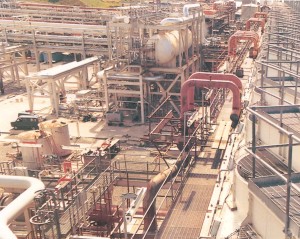Which materials can perform well in Phosphoric acid environments?
Pure phosphoric acid does not possess a suitable oxidizing power and is called as a non-oxidizing acid similar to dilute sulfuric acid. On the other hand, commercial phosphoric acid possesses contaminants of fluorides, chlorides etc that significantly increase its vigorousness. Oxidizing compounds like ferric salts, may also occur to influence the corrosion. Probably the variations in impurity concentrations of acids evaluated, the corrosion rates do not always agree. The recommended alloy for use with phosphoric acid are Incoloy 825, Inconel 625 and Hastelloy C276.
Nickel 200
There are limited applications of Nickel 200 in phosphoric acid. In pure and unaerated acid, the corrosion rates of Nickel 200 are nominal at all concentrations at normal temperatures. In warm or concentrated acid, the corrosion rates are high.
Monel 400
Monel 400 is known for offering significant resistance to pure phosphoric acid. It is corroded at low rates of about 10 mpy for all concentrations at temperatures up to 176oF. At higher temperatures, the corrosion rates may increase considerably. Corrosion rates in crude phosphoric acid can be high due to the presence of oxidizing salts. Even 0.4% ferric ion may cause the corrosion of Monel 400 to a significant level.
Incoloy 825
Incoloy 825 provides outstanding corrosion resistance to pure phosphoric acid at all concentrations and temperatures up to including 85% acid. Lab and plant corrosion tests show in commercial phosphoric acid conditions, considerable pitting or crevice corrosion would limit the use of Incoloy 825.
Inconel 600
Inconel 600 resists phosphoric acid at room temperature. Although the corrosion rates increases significantly with temperature.
Inconel 625, Hastelloy C276
The presence of high chromium and molybdenum concentrations in addition of nominal magnitude of niobium or tungsten, these alloys provide outstanding resistance to phosphoric acid. Incoloy 825 also offers the best performance in pure, concentrated and boiling acid. Although they show supreme resistance in the presence of significant magnitudes of chlorides and fluorides, they may cause pitting of Incoloy 825. Inconel 625 provides supreme performance in a solution of 25% phosphoric acid and 2% hydrofluoric acid at boiling point. Prolong tests in real service show the nominal rates and no localized corrosion in evaporating wet process phosphoric acid. The outcomes of other plant exposures for Inconel 625 are evaluated. The super alloys are ordered according to their corrosion resistance in commercial pure phosphoric acid in decreasing order:
Hastelloy C276> Inconel 625 > Incoloy 825 > Monel 400
The selection of a material for handling phosphoric acid is based on the concentration, temperature, velocity and extent of aeration of the acid, and presence of contaminants. Similar to other non-oxidizing acids, aeration or the presence of chemicals increase the corrosive attack on most metals. The commonly used nickel alloys in processes comprising phosphoric acid are Incoloy 825, Inconel 625, Hastelloy C276 and others.


